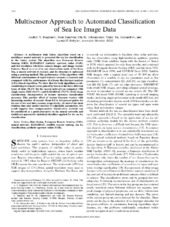Multisensor approach to automated classification of sea ice image data
Journal article, Peer reviewed
Published version

Åpne
Permanent lenke
https://hdl.handle.net/1956/787Utgivelsesdato
2005-07Metadata
Vis full innførselSamlinger
Originalversjon
https://doi.org/10.1109/tgrs.2005.846882Sammendrag
A multisensor data fusion algorithm based on a multilayer neural network is presented for sea ice classification in the winter period. The algorithm uses European Remote Sensing (ERS), RADARSAT synthetic aperture radar (SAR), and low-resolution television camera images and image texture features. Based on a set of in situ observations made at the Kara Sea, a neural network is trained, and its structure is optimized using a pruning method. The performance of the algorithm with different combinations of input features (sensors) is assessed and compared with the performance of a linear discriminant analysis (LDA)-based algorithm. We show that for both algorithms a substantial improvement can be gained by fusion of the three different types of data (91.2% for the neural network) as compared with single-source ERS (66.0%) and RADARSAT (70.7%) SAR image classification. Incorporation of texture increases classification accuracy. This positive effect of texture becomes weaker with increasing number of sensors (from 8.4 to 6.4 percent points for the use of two and three sensors, respectively). In view of the short training time and smaller number of adjustable parameters, this result suggests that semiparametric classification methods can be considered as a good alternative to the neural networks and traditional parametric statistical classifiers applied for the sea ice classification.